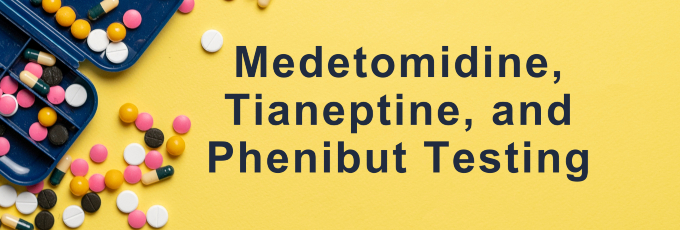Blog

We are excited to announce the addition phenibut, medetomidine, and tianeptine to our umbilical cord tissue, hair, and nail testing menus. These substances can be ordered as an individual test or an add-on to any umbilical cord tissue, hair, or nail drug panel beginning March 10, 2025.
Click here to learn more about our new phenibut, medetomidine, and tianeptine testing.
For more information on hair testing click here, for more information on nail testing click here, and for more information on umbilical cord tissue testing click here.

Jones, J. , Coy, D. and Jones, M. (2024) A Comparison of Turnaround-Times for Two Popular Specimen Types Used for Newborn Toxicology: Meconium and Umbilical Cord Tissue. Open Journal of Obstetrics and Gynecology, 14, 1541-1547. DOI: 10.4236/ojog.2024.1410123.

Screened Negative Results = ~24 Hours* Confirmed Results (positive/negative) = additional ~48-72 Hours*
*Estimates are calculated based on the time the specimen is received at our laboratory.
Abstract
Background: Prenatal exposure to illicit substances is responsible for several long-term negative health consequences. It is critical for healthcare professionals to know the extent and scope of prenatal substance exposure in their cases. Several studies exist with mixed results comparing the effectiveness of umbilical cord tissue (UCT) and meconium (MEC) as toxicology specimen types. The specific aim of this study is to compare the use of UCT and MEC regarding the time interval between the birth of the neonate, receipt of the specimen at the laboratory, and the hospital’s receipt of the final toxicology report.
Method: The study queried de-identified results of 5358 consecutive UCT and 706 MEC from our laboratory.
Results: The mean time from birth to receipt of the specimen at the laboratory for MEC and UCT was 4.5 days ± 2.9 days and 2.8 days ± 1.9 days, respectively. The mean time from birth to final report for MEC was 6.9 days ± 3.8 days, 5.7 days ± 3.3 days, and 8.4 days ± 3.8 days for all MEC specimens, negative MEC, and positive MEC, respectively. The mean time from birth to final report for UCT was 4.3 days ± 2.4 days, 3.5 days ± 2.2 days, and 5.4 days ± 2.2 days for all UCT, negative UCT and positive UCT, respectively.
Discussion/Conclusion: Receipt of drug test results of the neonate prior to release from the hospital is critical. This study shows that UCT offers an advantage when results are needed quickly to make informed decisions about the health and well-being of newborns.
Click here to read the full abstract. Click here to learn more about our Newborn Testing.
Jones, J., Coy, D., Gidron, D. et al. Using umbilical cord tissue to identify prenatal ethanol exposure and co-exposure to other commonly misused substances. J Perinatol (2024). https://doi.org/10.1038/s41372-024-02075-2
Abstract
Objective
Substance misuse during pregnancy can result in a variety of poor pregnancy outcomes. Objective data reporting the prevalence of neonates born with ethanol metabolites (evidence of prenatal ethanol exposure) in their fluids or tissues are limited.
Click here to read the full abstract. Click here to learn more about umbilical cord tissue testing.
Jones J (2023) Toxicology as a diagnostic tool to identify the misuse of drugs in the perinatal period. Front. Pediatr. 10:1071564. doi: 10.3389/fped.2022.1071564

Abstract
The use, misuse, and abuse of substances are a continued public health concern in this country and around the world. Perinatal exposure to substances of abuse is associated with several long-term negative consequences for the neonate. Limited resources exist to assist perinatal health professionals on this very complex subject. The purpose of this document is to provide additional information about selecting monitoring protocols, the specifics of appropriate testing methodologies, and the interpretation of toxicological findings. Understanding these concepts better allows perinatal healthcare professionals to be a voice for the voiceless in order to protect and enrich lives during this unprecedented opioid epidemic.
Acknowledgments
I would like to thank Loretta Finnegan for the encouragement to prepare this manuscript. Additionally, I would like to thank Guida Brown for reviewing and editing the paper.
Click here to read the full abstract. Click here to learn more about Newborn Testing.

We will be implementing an important update to our system over the weekend. Unfortunately, this means the system will be down over the weekend, 10/26-10/27.
As a result, there may be some delays in the processing of specimens. We appreciate your understanding and patience during this time. If you have any questions, please feel free to contact us.
Substance use disorders (SUDs) are ‘treatable, chronic diseases characterized by a problematic pattern of use of a substance or substances leading to impairments in health, social function, and control over substance use’ 1. Drugs of abuse exhibit their effect on the body through the body’s natural messengers, neurotransmitters. To get a basic understanding of neurotransmitters, please see this article here. Different drugs affect various neurotransmitters in different ways. Further understanding of drugs of abuse and their affected neurotransmitters can lead to a more complete understanding of the effects experienced by the user. This article will cover a few common neurotransmitters and how some drugs affect them.
Common Neurotransmitters
Norepinephrine is a neurotransmitter that plays a key role in attention, arousal, cognitive function and stress reactions2. It can also act as a hormone and contributes to the ‘fight or flight’ response in the sympathetic nervous system. High levels of norepinephrine are associated with increased concentration, increased alertness and arousal, enhanced retrieval of memory, and increased heart rate. Low levels of norepinephrine are associated with lack of energy and motivation, and decreased mood.
Dopamine is another neurotransmitter which is most known for playing a key role in the ‘reward’ center of the brain3. It is involved in memory, movement, mood, attention, and pleasurable reward and motivation. Dopamine can also affect blood pressure through manipulation of blood vessels. High levels of dopamine are linked to feelings of happiness, motivation, focus, and alertness while low levels of dopamine can cause fatigue, mood swings, memory loss, concentration problems and a low sex drive.
Serotonin is a neurotransmitter which plays a key role in sleep, mood, sexual drive, learning, memory, and happiness4. It also helps regulate body temperature and your hunger. Low levels of serotonin are thought to play a role in many mental health disorders such as anxiety, depression, schizophrenia, obsessive-compulsive disorder, and mania. High levels of serotonin can cause confusion, high blood pressure and muscle twitches, but can also have severe effects such as fever and seizures.
Drug Classes
Amphetamine, cocaine, and hallucinogens all affect the levels of norepinephrine, dopamine and serotonin in the body.
Cocaine causes an elevated amount of norepinephrine, dopamine, and serotonin in the body by preventing the reuptake of those neurotransmitters5. In other words, those neurotransmitters get ‘trapped’ next to the receptors, so the receptors continuously send out signals

 Cocaine has a stronger effect on norepinephrine and dopamine than it does on serotonin.
Cocaine has a stronger effect on norepinephrine and dopamine than it does on serotonin.
Amphetamine also causes an increased amount of norepinephrine, dopamine, and serotonin in the body, but does so through various mechanisms of action6. Like cocaine, amphetamine prevents reuptake, but amphetamine also has been reported to inhibit the neurotransmitter metabolism, allowing the neurotransmitter to have more time to bind to receptors and release signals6

 Amphetamines, like cocaine, have a stronger effect on norepinephrine and dopamine than it does on serotonin.
Amphetamines, like cocaine, have a stronger effect on norepinephrine and dopamine than it does on serotonin.
Hallucinogens act differently than amphetamines and cocaine in the fact that hallucinogens act as serotonin and dopamine agonists7. In other words, these hallucinogens act like serotonin, binding to the serotonin receptors and activating them, even when serotonin is not available.

Also, unlike amphetamine and cocaine, hallucinogens have the strongest effect on serotonin.
Even though amphetamine, cocaine, and hallucinogens all affect the same neurotransmitters, the overall effects experienced by the user for each drug class are vastly different. This is because each drug class has different mechanisms of action, and they affect each neurotransmitter to different degrees. Understanding neurotransmitters and how the drug classes affect them can help us to understand the effects experienced by different illicit substances.
References:
-
CDC. “Disease of the Week – Substance Use Disorders (SUDs).” Centers for Disease Control and Prevention, 5 Oct. 2022, https://www.cdc.gov/dotw/substance-use-disorders/index.html#:~:text=Substance%20Use%20Disorders%20(SUDs)%20are,and%20con
-
Hussain, Laila S., et al. “Physiology, Noradrenergic Synapse.” PubMed, StatPearls Publishing, 2022, https://www.ncbi.nlm.nih.gov/books/NBK540977/#:~:text=First%20identified%20in%20the%201940s,cognitive%20function%2C%20and%20stress%20reactions.
-
Cleveland Clinic. “Dopamine.” Cleveland Clinic, Cleveland Clinic, 23 Mar. 2022, https://my.clevelandclinic.org/health/articles/22581-dopamine
-
Cleveland Clinic. “Serotonin.” Cleveland Clinic, Cleveland Clinic, 18 Mar. 2022, https://my.clevelandclinic.org/health/articles/22572-serotonin
-
Sora, I., et al. “Molecular Mechanisms of Cocaine Reward: Combined Dopamine and Serotonin Transporter Knockouts Eliminate Cocaine Place Preference.” Proceedings of the National Academy of Sciences, vol. 98, no. 9, 24 Apr. 2001, pp. 5300–5305, https://www.pnas.org/doi/10.1073/pnas.091039298
-
Martin, Dustin, and Jacqueline K. Le. “Amphetamine.” PubMed, StatPearls Publishing, 2021, https://www.ncbi.nlm.nih.gov/books/NBK556103/#:~:text=Go%20to%3A-,Mechanism%20of%20Action,through%20a%20variety%20of%20mechanisms.
-
“Brain Mechanisms of Hallucinogens and Entactogens.” New Perspectives in Chronic Psychoses, vol. 3, no. 4, Dec. 2001, pp. 265–279, https://www.ncbi.nlm.nih.gov/pmc/articles/PMC3181663/#:~:text=Recent%20electrophysiological%20studies%20have%20produced,receptors%20in%20the%20frontal%20cortex

We are excited to announce that we are the only laboratory in the world to offer delta-8-THC, delta-9-THC, delta-10-THC, and cannabidiol testing for environmental exposure in hair (ChildGuard®).
Effective February 19, the following parent/native cannabinoids became available in ChildGuard® testing:
- ∆8-THC
- ∆9-THC
- ∆10-THC
- Cannabidiol (CBD)
The presence of any of these cannabinoids in hair or nails is evidence of environmental exposure to the specific cannabinoid detected and does not infer ingestion of the cannabinoid.
The difference between these cannabinoids is caused by a double bond on the eighth, ninth, or tenth carbon atom. The minor differences in these cannabinoids cause them to exert different levels of psychoactive effects. To learn more about the difference between delta-8 and delta-9 specifically, here is a resource we found useful.
The FDA has also released a warning letter for alleged Cannabidiol-Related products containing more THC than they claim to.
We encourage you to read these resources to learn more about the topic.
If you have any questions regarding these changes, please contact our Client Services Department at 800.235.2367, or email clientservices@usdtl.com.
- Hair, Nail, and Umbilical Cord Testing for Phenibut, Medetomidine, and Tianeptine
- Umbilical Cord Tissue Testing for SSRIs
- A Comparison of Turnaround-Times for Two Popular Specimen Types Used for Newborn Toxicology: Meconium and Umbilical Cord Tissue
- Using Umbilical Cord Tissue to Identify Prenatal Ethanol Exposure and Co-exposure to Other Commonly Misused Substances
- Toxicology as a Diagnostic Tool to Identify the Misuse of Drugs in the Perinatal Period
- Specimen Delay
- Drug Classes and Neurotransmitters: Amphetamine, Cocaine, and Hallucinogens
- Environmental Exposure Testing for Delta-8 THC, Delta-9 THC, Delta-10 THC, and CBD
- February 2025 (1)
- October 2024 (5)
- March 2024 (1)
- February 2024 (1)
- January 2024 (3)
- December 2023 (1)


